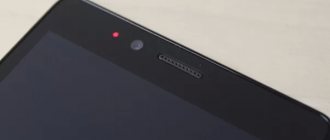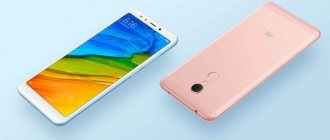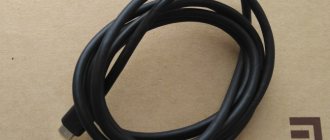Colors and appearance of smartphones
| Honor 7A | Honor 7S |
| Colors | |
You can’t find fault with the appearance of the devices. Both models are available in the same 3 colors: gold, blue and black. Both phones are available in the same number of colors.
Our conclusions
First, let's find out the price of these devices. We will compare modifications with the same amount of RAM and ROM, that is, 4/64 GB. The 7x will cost around $270. And 9 lite costs $240. Considering the disadvantages that the 7x has, it is clearly not the best choice in this price category.
Honor 7X
Of course, Honor 7 X is a good device. It has a great screen, a good processor, a decent battery, and it's a relatively new model. But if you compare it with 9 lite, the difference is painfully visible. Honor 9 Lite has a better camera, it is more compact, more convenient, and most importantly - cheaper. Price plays a major role when choosing a model, and it’s clearly not worth paying a couple of thousand more just for the fact that the screen will be a little larger and the battery will be a little better. In addition, the “nine” is a little newer, it has better software installed.
What to choose – Honor 7x or 9 light, of course, is up to you to decide, but still, when choosing a model, you should carefully weigh the pros and cons. And in our opinion, in the confrontation between Honor 9 lite and Huawei 7x, the “nine” wins, because it is the best value for money.
Phone size
| Honor 7A | Honor 7S | |
| Screen diagonal | 5.45 inches | 5.45 inches |
| Length | 14.65 cm. | 14.65 cm. |
| Width | 7.09 cm. | 7.09 cm. |
| Thickness | 0.83 cm. | 0.83 cm. |
| Weight | 150 grams | 142 grams |
For reference: there are 2.54 cm in one inch.
What's better - a large display that's easy to watch videos on, or a compact phone that fits easily into any pocket? There is no clear answer. But let's return to the smartphones in question - they have the same display size of 5.45 inches.
Battery and autonomy
New Chinese smartphones are equipped with batteries with a capacity of 3750 mAh for Honor 20 and 3650 mAh, and for Huawei P30, the difference is only 100 mAh. Devices charge quickly. Below are the test results for autonomy.
Honor 20:
- Communication on a 3G network: 32:20 hours.
- Entertainment on the Internet using Wi-Fi: 13:25 hours.
- Video: 14:14 hours.
- Charging speed with your device 22.5 W: 50% in half an hour.
Huawei P30:
- Communication on a 3G network: 22:38 hours.
- Entertainment on the Internet via Wi-Fi: 13:52 hours.
- Video: 16:22 hours.
- Charging speed with the main device 22.5 W: 65% in half an hour.
The winner in terms of autonomy is Honor 20, as it gives you the ability to talk on the phone for ten hours longer.
Screen Specifications
Let's now compare the main characteristics of the display. We will be interested in pixel density, resolution and other available parameters.
| Honor 7A | Honor 7S |
| Display name | |
| IPS LCD | LCD |
| Display Description | |
| 16M colors | 16M colors |
| Screen resolution, pixels | |
| 720×1440 | 720×1440 |
| Pixels per inch | |
| 295 | 295 |
What can I say? There are no differences in the given characteristics.
Processor, memory size and battery
This section presents a block of data that allows you to understand how significant the difference in performance is.
| Honor 7A | Honor 7S |
| CPU frequency | |
| 1.4 GHz | 1.5 GHz |
| Built-in memory | |
|
|
| Memory card slot | |
| yes, up to 256 GB, separate | yes, up to 256 GB |
| RAM | |
| 2 GB. | 1 GB. |
| Battery capacity | |
| 3020 mAh | 3020 mAh |
| Talk time | |
| until 17 o'clock | until 33 o'clock |
As advantages of the Honor 7A, we note the amount of built-in memory and the amount of RAM, while the Honor 7S has processor speed and talk time.
Honor 7C
The large (5.7-inch) diagonal frameless screen, protected by a special 2.5D glass, as well as virtual control keys immediately introduces this smartphone to the category of modern ones. With dimensions of 152.4x73x8.05 mm, the device turned out to be quite ergonomic, and due to its long shape it fits comfortably in the hand. On the rear panel there is a camera unit with two lenses and a flash, as well as a “sensitive” fingerprint sensor. The connector for charging and transferring files is a standard MicroUSB.
Reference. With a resolution of 1400x720, corresponding to the HD format, some experts note that the image transmission is far from ideal.
The manufacturer installed an eight-core Snapdragon 450 in the smartphone as a processor. The processor clock frequency is 1800 MHz, which, together with the Adreno 506 video accelerator, is designed to increase the device’s performance when working with games and videos. With all this, the smartphone received a “standard” 3 GB of RAM.
As for the operating system, Honor 7C is equipped with the “eighth” Android with EMUI 8. The device supports opening several tabs without any problems, but it can still freeze a little in games with high graphics and “heavy” applications. If we talk about the “optics” of the device, then a fairly good main 13-megapixel camera, coupled with an additional 2-megapixel camera, allows you to take high-quality photos with background blur (and without it), and the built-in flash, if necessary, provides bright illumination for the picture. Video is recorded with a resolution of 1920x1080 at 30 fps.
Reference. The eight-megapixel front camera also has fairly high image quality for the price segment of this smartphone.
Camera options
We all love high-quality photographs. Let's compare the parameters that determine them.
| Honor 7A | Honor 7S |
| Main camera | |
| One 13 MP camera | One 8 MP camera |
| Matrix resolution | |
| 13 MP | 13 MP |
| Digital zoom | |
| – | – |
| Front camera matrix resolution | |
| 5 MP | 5 MP |
We found no differences in the basic characteristics of the cameras. The difference may be in additional functions - see the corresponding section of the review.
additional characteristics
To complete the picture, we present some more data from the compared models. Perhaps one of them will determine your choice
| Honor 7A | Honor 7S |
| SIM card | |
| Supports 2 cards: nano SIM | Supports 2 cards: nano SIM |
| Image stabilization | |
| – | – |
| Video recording, frame rate | |
| 1080p at 30fps | 1080p at 30fps |
| Water protection | |
| – | – |
| NFC module | |
| – | – |
| Geolocation | |
| A-GPS, GLONASS, GPS | GLONASS, GPS |
| Authentication | |
| – | – |
| Headphone jack | |
| mini jack 3.5 mm | mini jack 3.5 mm |
We have made all the main comparisons. We hope you now have enough information to make your choice.
Detailed technical specifications
Make and model
Make and model of the device, and alternative names (if any).
| Brand Device manufacturer company. | Huawei |
| Model Device name. | Honor 7X |
| Alternative names Other model names, if available. Sometimes the model is called differently, depending on the country or because of popular nicknames. | BND-AL10 BND-L21 BND-L24 BND-TL10 |
Design
Appearance of the device including dimensions, weight, volume, colors and materials.
| Width The horizontal side of the device when used in standard orientation. | 75.3 mm (millimeters) |
| Height The vertical side of the device when used in standard orientation. | 156.5 mm (millimeters) |
| Thickness The cross-sectional size of the device. | 7.6 mm (millimeters) |
| Weight How much does the device weigh excluding the case, SIM and memory cards and other additional elements. | 165 g (grams) |
| Volume Approximate value calculated using the formula: length times width times height. | 89.56 cm³ (cubic centimeters) |
| Colors What colors is the device available in? | Golden Black Blue Red |
| Housing materials What materials is the body made of? | Aluminium alloy |
System on a Chip (SoC)
A system on a chip, a single-chip system (System on a Chip, SoC) is when several systems performing different device functions are connected on one chip.
| System on a Chip (SoC) A single-chip system that contains components such as a processor, graphics accelerator, memory units, communication interfaces, etc., as well as software for the operation of the system. | Huawei HiSilicon KIRIN 659 |
Central processing unit (CPU)
| Central processing unit (CPU) The main component of the device is responsible for calculations and data processing. | 4x 2.36 GHz ARM Cortex-A53, 4x 1.7 GHz ARM Cortex-A53 |
| Technical process What technological process is used to make the chip? The smaller the process technology, the better - the chips consume less power and generate less heat. | 16 nm (nanometers) |
| Processor size Processor capacity is a parameter that indicates how many bits of data a processor register processes in 1 clock cycle. This is usually 32 or 64 bits. | 64 bit |
| Instruction Set Architecture Instruction set architecture (ISA) is a programmable part of the microprocessor core used by software to control the operation of the processor. | ARMv8 |
| Number of processor cores The processor can be either single-core or multi-core. The performance of the processor depends on the number of cores (threads). The more cores working simultaneously, the higher the power consumption, so in mobile devices all cores are used only under high load. | 8 |
| CPU clock speed Clock speed is the number of operations per second that a processor or its core can achieve. The higher the frequency, the higher the overall performance of the device, but performance also depends on the processor architecture and the number of cores. | 2360 MHz (megahertz) |
Graphics Processing Unit (GPU)
| Graphics Processing Unit (GPU) The graphics processing unit (GPU) is used to process and display graphics - 3D effects, games, interfaces and other visual elements. Due to the pipeline architecture, the GPU is many times more efficient in graphics processing than the processor. | ARM Mali-T830 MP2 |
| Number of GPU cores Similar to a processor, a GPU can have one core or several. The number of cores (threads) determines the performance and amount of information processed. The more cores, the better. | 2 |
Random access memory (RAM)
| Amount of random access memory (RAM) RAM (Random Access Memory, RAM, RAM) is temporary memory (works only while the device is running), which stores data and code for the operational operation of programs and applications. The more RAM, the more programs you can run simultaneously without loss of performance (there will be fewer “brakes”). | 3 GB (gigabytes) 4 GB (gigabytes) |
| Type of random access memory (RAM) Information about the type of RAM used by the device. | LPDDR3 |
| Number of RAM channels 1 is a single-channel RAM operating mode, basic, when 1 memory module is used. 2 is already a two-channel mode - a mode of parallel operation of 2 modules or pairs of modules, memory channels - this mode is 2 times faster than a single-channel one. 3 – three-channel mode is 3 times faster than single-channel mode. | Dual channel |
| RAM frequency The frequency of RAM determines the speed of RAM, or rather the speed of data transfer and reception. In theory, the higher the frequency, the more powerful the RAM. | 933 MHz (megahertz) —- i5 coprocessor GPU Turbo |
Built-in memory
Most mobile devices have built-in Flash memory, which is used as a storage for system data, the operating system, as well as user data - photos, videos, recordings and much more.
| Built-in memory capacity The higher the amount of built-in memory, the more games, programs, music, videos and your other files will fit in the device, especially the amount of memory is important when the device does not support memory cards. | 32 GB (gigabytes) 64 GB (gigabytes) 128 GB (gigabytes) |
Operating system
A mobile operating system (OS) is pre-installed software with a well-thought-out interface for user control of device functions.
| Operating system (OS) The operating system installed by default by the device manufacturer, as well as its version. | Android 7.0 Nougat Android 8.0 Oreo Android 9.0 Pie |
| User interface User interface (UI - user interface) is usually a graphical shell that ensures the transfer of information between the user and the operating system. | EMUI 5.1 EMUI 8.0 EMUI 9.0 EMUI 9.1 |
Battery
To operate autonomously, a mobile device requires a battery that powers all its components.
| Battery capacity The main characteristic of a battery is its maximum capacity, that is, the charge it can store. Capacity is measured in mAh (mAh, milliamp-hour). The higher the capacity, the longer the mobile device can work. | 3340 mAh (milliamp-hours) |
| Battery type Many types of batteries have been used in portable devices, but NiCd (nickel-cadmium), NiMH (nickel-metal hydride), and even more so SLA (lead-acid) batteries are already considered obsolete. Instead, modern mobile devices use Li-Ion (lithium-ion) and Li-Pol, Li-Poly (lithium-polymer) batteries. | Li-polymer |
| Power adapter Characteristics of the charger (adapter, power supply) included in the standard package of the mobile device. More precisely, the output voltage in volts (V) and the output current in amperes (A). | 5 V (volts) / 2 A (amps) |
Screen
The screen (display) is the main element for displaying graphic information.
| Technology The technology used to make the screen. There are many types of display manufacturing with their pros and cons. | IPS |
| Diagonal The screen diagonal of a device is measured in inches (inch, in or simply ″), and 1″ is equal to 2.54 cm. | 5.93 in (inches) 150.62 mm (millimeters) 15.06 cm (centimeters) |
| Width Approximate screen width | 67.36 mm (millimeters) 6.74 cm (centimeters) |
| Height Approximate screen height | 134.72 mm (millimeters) 13.47 cm (centimeters) |
| Aspect Ratio Aspect ratio is the ratio of the shorter side of the screen, which is considered to be 1, to the longer side, which is denoted by a decimal fraction indicating the ratio to the short side. | 2:1 2:1 (18:9) |
| Screen resolution Screen resolution is the number of horizontal pixels (dots) multiplied by the number of vertical pixels. The higher the resolution, the more detailed the image will be. | 1080 x 2160 pixels |
| Pixel Density The number of pixels per inch or PPI (pixels per inch) indicates the density of pixels per 1 inch (2.54 cm) of the screen. The higher the PPI, the sharper the image, and the less visible or even invisible “squares and dots” (pixels). | 407 ppi (pixels per inch) 159 ppcm (pixels per centimeter) |
| Color depth Color depth means how many bits are used in 1 pixel to display color (bits per pixel). | 24 bit 16777216 colors |
| Screen area Approximate usable area occupied by the screen on the front of the device. The higher the percentage, the narrower the frames around the display or the smaller the “chin with bangs.” | 77.26% (percent) |
| Touch screen A touch screen is a device that usually covers the display and is a touch input tool. In fact, in mobile devices, the touchscreen is a replacement for the keyboard and mouse. | Yes |
| Touch screen type There are many types of touch screens, with their pros and cons. Mobile devices often use capacitive touchscreens, but technology does not stand still and new types of sensors are appearing. | Capacitive |
| Multi-touch Touch screen support for two or more touches. For example, zooming photos with two fingers. | Yes |
| Impact-resistant protective glass of the display The screen and touchscreen of a mobile device are usually covered with protective tempered glass (sometimes plastic or film is used instead of glass) to protect the display from impacts and scratches. Many companies are engaged in the production of such protection, but the most famous are Corning - Gorilla Glass and Asahi - Dragontrail. | Yes Corning Gorilla Glass |
| 2.5D screen 2.5D is a display with rounded edges. Device manufacturers use a 2.5D screen as a design element, for a pleasant tactile sensation, or to add durability, dust and moisture protection. | Yes |
Main camera
The main camera, usually built into the rear of the device, is designed for creating photo and video content.
| Maximum image resolution This is the maximum number of pixels (dots) horizontally and vertically. The higher the resolution, the more detailed the image will be. Resolution can also be indicated in megapixels - this is the total number of pixels that can be in the image, calculated by the formula: vertical pixels multiplied by the number of horizontal pixels and divide the resulting amount by 1 million. | 4608 x 3456 pixels 15.93 MP (megapixels) |
| Matrix type There are two main types of photomatrix, CCD (Charge-Coupled Device) and CMOS (Complimentary Metal-Oxide Semiconductor). Mobile devices mainly use a CMOS matrix - it requires less space, has low power consumption and heating. Recently, new types of sensors have begun to appear, for example PureCel from OmniVision. | CMOS (complementary metal-oxide semiconductor) |
| Focal length Focal length is the distance from the center of the lens to the image sensor. | 3.81 mm (millimeters) |
| Diaphragm Aperture (f-number, f) is used to control the light flux passing through the lens. The aperture is indicated by a fraction, and the smaller the fractional number, the higher the aperture passing through the lens. The more light that passes through the lens, the better overall, less noise in your photos and better night photography. | f/2.2 |
| Flash type Most mobile devices are equipped with light-emitting diode (LED) flashes, but there are also xenon flashes. As a flash, xenon is better - it is more powerful, but LED is more versatile (can work as a flashlight) and consumes less electricity. | LED |
| Maximum video resolution This is the maximum number of pixels (dots) horizontally and vertically. The higher the resolution, the more detailed the image will be. | 1920 x 1080 pixels 2.07 MP (megapixels) |
| FPS video recording at maximum resolution FPS (Frames per Second, frame rate) is the number of frames that changes in 1 second. The higher the number of frames per second, the smoother the image will be. In this case, we mean the number of frames that the camera can achieve at its maximum resolution; the lower the resolution, the higher the FPS can be. | 30 fps (frames per second) |
| Presence of flash Incorporating a flash into a mobile device allows you to take pictures in low light conditions. Creates the necessary lighting and compensates for the lack of natural light. | Yes |
| Digital zoom With digital zoom (zoom, enlargement), the subject is brought closer due to software image algorithms. The higher the magnification with digital zoom, the worse the image quality (noise, blur) will be compared to a non-zoomed one. | Yes |
| Focus on face Function of auto-detection of living objects and autofocus on their face or head. | Yes |
| Panoramic shooting mode Panoramic photography is a series of frames where each subsequent frame is a continuation of the previous one; at the end of the shooting, all frames are stitched together at the software level to create a panoramic photograph. Frames can be shot both vertically and horizontally, and their width can be up to 360 degrees. This type of shooting is used when the camera's viewing angle is not enough to capture the entire scene. | Yes |
| HDR shooting mode HDR photography takes a quick series of shots with highlights, midtones, and shadows, then combines them into a single frame with high dynamic range. | Yes |
| White balance White balance is a setting that helps ensure the correct color reproduction in an image by determining the color temperature of the light source in the frame. The balance can be set either automatically or manually. | Yes |
| ISO Setting ISO is the level of light sensitivity. The lower the ISO, the less sensitive the camera's light sensor and the smoother the image with less noise. The higher the ISO, the higher the light sensitivity, but more noise, graininess, or decreased sharpness. | Yes |
| Additional Information Additional information about the functions and characteristics of cameras. | Autofocus Continuous shooting Geo-tagging Touch focus Exposure compensation Self-timer Scene select mode |
Additional cameras
Secondary cameras allow you to expand the capabilities of the main camera, such as adding a wide shooting angle, sharpness, optical zoom and other functions depending on the type of secondary camera.
| Second additional camera | 2 MP (megapixels) |
Front-camera
The front camera of a mobile device (selfie camera, rear camera) is a camera on the front part, which is usually used for video communication, recognition of gestures or faces, and selfie photographs.
| Photo resolution The maximum image resolution that the camera can produce. As resolution increases, image detail increases. Resolution can also be indicated in megapixels (the total number of pixels that an image can consist of) - these are vertical pixels multiplied by horizontal pixels and divided by 1 million. | 3264 x 2448 pixels 7.99 MP (megapixels) |
| Matrix type There are not many types of matrices, the main ones are CCD, PureCel and the most popular in mobile devices due to low power consumption and compact size - CMOS. | CMOS (complementary metal-oxide semiconductor) |
| Diaphragm An aperture (or aperture) is essentially an adjustable baffle to control the amount of light passing through the lens. The aperture is indicated by a fraction, and the smaller it is, the more light passes through the lens, which has a positive effect on photographs - there will be less noise and better night photography. While the main cameras also come with an adjustable aperture, most front cameras have a fixed aperture. | f/2 |
| Video resolution This is the maximum resolution the camera can record video at. The higher the resolution, the better. | 1920 x 1080 pixels 2.07 MP (megapixels) |
| Frame rate (FPS) of video shooting This is talking about FPS at maximum video resolution; at lower resolutions, the frame rate per second can be higher. FPS determines the smoothness of the video, as well as the ability to speed up or slow down it. | 30 fps (frames per second) — Focal length (35 mm equivalent) — 27 mm |
| Camera focal length Focal length is the distance from the center of the lens to the sensor. The focal length determines the viewing angle, scale and degree of blur. | 2.82 mm (millimeters) |
Memory card
A memory card (flash card) is an external data storage device that is used in many devices to increase memory capacity.
| Memory card type and formats Mobile devices usually use 3 types of memory cards - SD, miniSD and the most common microSD. Each type has its own formats that the device supports. | microSD microSDHC microSDXC |
SIM card
Subscriber Identification Module (SIM) used in mobile devices to identify subscribers in cellular networks.
| Type, size of SIM card A regular (mini SIM) card has dimensions of 25x15 mm. Micro SIM - 15x12 mm. Nano SIM - 12.3x8.8 mm. The sizes of SIM cards are different and not interchangeable. There is also an eSIM (virtual, electronic SIM card), it is built into the device and does not take up space. | Nano-SIM (4FF - fourth form factor, since 2012, 12.30 x 8.80 x 0.67 mm) Nano-SIM / microSD |
| Number of SIM cards How many SIM cards does the device support? | 2 |
Mobile networks
This is a system in which communication and data transfer is carried out between subscribers, the location of one or more of which changes. This section lists the supported mobile communication standards and frequencies.
| GSM GSM (Global System for Mobile Communications) is a standard for digital mobile cellular communications of the second generation 2G with time and frequency division of channels. GSM came to replace analog cellular communications 1G (first generation). | GSM 900 MHz GSM 1800 MHz GSM 1900 MHz |
| CDMA CDMA (Code Division Multiple Access) - this mobile communication standard can be classified as a 2.5G network (generation), unlike 2G, CDMA has higher speech quality, higher cellular network capacity and increased data transfer speed. | CDMA 800 MHz |
| TD-SCDMA TD-SCDMA (Time Division Synchronous Code Division Multiple Access) is a third generation (3G) mobile communications standard used in China. | TD-SCDMA 1880-1920 MHz TD-SCDMA 2010-2025 MHz |
| UMTS UMTS (Universal Mobile Telecommunications System), also called 3GSM, is a third generation (3G) mobile communications standard based on the WCDMA air interface. | UMTS 850 MHz UMTS 900 MHz UMTS 1900 MHz UMTS 2100 MHz |
| LTE LTE (Long-Term Evolution, often referred to as 4G LTE) is a standard for wireless high-speed data transmission, which, although it belongs to fourth generation networks (4G), is essentially a transitional stage from 3G to 4G, greatly accelerating data transfer speeds. The standard has an improved version, LTE Advanced (LTE-A), which can already be considered a full-fledged 4th generation network. | LTE-TDD 1900 MHz (B39) LTE-TDD 2300 MHz (B40) LTE-TDD 2500 MHz (B41) LTE-TDD 2600 MHz (B38) LTE 850 MHz LTE 900 MHz LTE 1800 MHz LTE 2100 MHz LTE 2600 MHz |
Mobile network data standards
What data transfer standards in cellular networks are supported by the device, as well as their speed.
| Data transmission technologies Technologies for receiving and transmitting data, as well as their maximum speed. | UMTS (384 kbit/s) EDGE GPRS HSPA+ (HSUPA 5.76 Mbit/s, HSDPA 42 Mbit/s) LTE Cat 6 (51.0 Mbit/s, 301.5 Mbit/s) EV-DO Rev. A (1.8 Mbit/s, 3.1 Mbit/s) TD-SCDMA TD-HSDPA |
WiFi
Wi-Fi (Wireless Fidelity) is a technology for wireless data transmission over a local network among devices based on IEEE 802.11 standards.
| Wi-Fi Direct support The Wi-Fi Direct protocol allows multiple devices to connect directly, bypassing the use of routers or access points. | Yes |
| Wi-Fi Hot-Spot A hotspot is a Wi-Fi access point. In a mobile device, Hot-Spot turns the smartphone into a Wi-Fi access point, essentially turning it into a router capable of distributing the Internet. | Yes |
| WiFi Supported WIFI wireless network standards. | 802.11b (IEEE 802.11b-1999) 802.11g (IEEE 802.11g-2003) 802.11n (IEEE 802.11n-2009) |
Bluetooth
Bluetooth (BT, bluetooth (z), “blue tooth”) is a short-range wireless network (up to 10, sometimes 100 meters) operating on radio waves to transmit voice and data between devices.
| Bluetooth version Bluetooth technology is actively developing and, since 1998, has been constantly updating versions of the standard. Each subsequent version introduces one or several improvements in data exchange speed, range, facilitates pairing, reduces power consumption, or introduces some new protocols and operating profiles. The higher the Bluetooth version, the better. The technology is also backward compatible, for example, if your mobile device has version 5.0, then it will work with accessories version 4.2 and lower, but the improvements introduced in version 5.0 will not work; they will work only if both the device and accessories are version 5. | 4.1 |
| Bluetooth Low Energy (BLE) Bluetooth LE is a low energy BT protocol specification. | Yes |
| A2DP profile The A2DP Bluetooth profile is designed to transmit a high-quality two-channel stereo signal via Bluetooth to wireless headphones, speakers and other acoustics. | Yes |
Sensors
Modern devices have many sensors that help in measurements, trigger functions, and make using the device more pleasant.
| Light sensor The light sensor reacts to the light level and is able to adjust the screen brightness automatically based on this. This is necessary to reduce power consumption and ease of use of the device. | Yes |
| Proximity sensor The proximity sensor reacts to the proximity of the mobile device to some object. For example, the sensor is used when talking on the phone to turn off the screen, which saves energy and prevents you from pressing buttons with your ear or cheek. | Yes |
| Accelerometer An accelerometer is a sensor that measures apparent acceleration, that is, it determines the position and distance at which a mobile device moves in space. Based on the data from this sensor, the screen orientation change, pedometer, control using tilts and gestures in games and applications, etc. work. | Yes |
| Fingerprint's scanner The scanner is responsible for authorization using a previously saved fingerprint, as a result of which the device is unlocked, payment is made, some action is confirmed - just put your finger on the scanner. Scanners can be either built into the body or built into a button or screen. | Yes |
| Digital compass This is software that displays data from a magnetic sensor or GPS in the form of a compass on the screen of a mobile device. If there are no sensors or GPS, then the digital compass will not work. | Yes |
| Additional sensors | —- |
Audio
Audio - characteristics and capabilities of a mobile device in terms of sound.
| Music speaker There are two types of speakers in mobile devices - auditory and musical. The auditory speaker (speaker) is used for conversation, the music speaker (buzzer) is used to play music and sounds. | Speaker |
Radio
The radio in a mobile device can be built-in by the manufacturer (catch local radio channels, no internet required, often works only with headphones (as an antenna), but not always) or installed as an online application (requires internet, but more channels and often better quality) .
| Built-in radio Is a radio tuner integrated into the mobile device? | Yes |
Navigation and location
The location is determined by satellite navigation systems that track the device's autonomous geospatial location at multiple points. The most common satellite navigation systems are GPS, GLONASS, and the Chinese BeiDou.
| GPS GPS (Global Positioning System) is a global satellite navigation system that can determine the position of a mobile device, build routes and find the desired object on the map with an accuracy of several meters. | Yes |
| A-GPS A-GPS (Assisted GPS) is an assistive technology that will help you quickly find the location of your cellular device without waiting for satellite data, which is especially important in indoors and cities. Location is determined in various ways, for example, Wi-Fi access points, mobile towers, bluetooth and others. | Yes |
| GLONASS GLONASS is a Russian Global Navigation Satellite System, which is similar to GPS and works in tandem with it, increasing the accuracy and speed of navigation. | Yes |
| Additional navigation systems | BeiDou |
USB connector
USB (Universal Serial Bus) is a serial interface for connecting peripherals to computers, smartphones, laptops and much more. The interface allows you to exchange data and power a peripheral device with energy, as well as connect several peripheral devices to one USB connector at once.
| Connector type What type of USB connector is used in the device. | Micro USB |
| USB standard The higher the standard, the faster the throughput, or more precisely the data exchange rate. With version 3.0 of the standard, the current was increased to 0.9A, eliminating the need for additional power for some devices. | 2.0 |
| USB Mass Storage Connecting a mobile device via USB as a data storage device. That is, when you enable this mode, your device can be used as a flash drive. | Yes |
| Additional characteristics Additional features of the USB connector, for example, OTG, whether the connection is supported, peripheral devices and additional memory. | Charging via USB |
Headphone jack
A TRS headphone jack (or jack) is a common standard of connectors used for transmitting audio signals. By diameter there are jack (6.5 mm), mini-jack (3.5 mm) and micro-jack (2.5 mm). In mobile devices, the 3.5mm jack was considered the most popular and widespread, but recently they began to be removed, leaving only USB connectors, through which headphones are connected with a corresponding plug or using adapters.
| 3.5mm headphone jack Does the device have a 3.5 mm audio jack? | Yes |
Connection and synchronization
Options for synchronizing your mobile device and connecting it to other devices.
| Connection, synchronization Types of synchronization and connection technologies supported by the device. | Computer sync OTA sync Tethering VoLTE |
Browser
A browser is a browser program for viewing sites and their content on the Internet. Through the browser, you can open websites, search for information, download necessary files, watch streaming videos, play browser games, etc.
| Technologies Markup and programming languages supported by the built-in (standard) browser. For mobile devices, you can install additional browser applications if the standard one does not suit you. | HTML HTML5 CSS 3 |
Audio file formats/codecs
Mobile devices support many audio file formats, as well as codecs for playing them.
| Default formats The formats that the mobile device supports out of the box are indicated. But if the device does not support the format you need, then you can try adding support for it. Sometimes support depends on the technical characteristics of the device (“hardware”) and nothing can be added here, but often the ability to process a particular audio format depends on the software part. You can install another audio player or codec set separately. | AAC (Advanced Audio Coding) AAC+ / aacPlus / HE-AAC v1 AMR / AMR-NB / GSM-AMR (Adaptive Multi-Rate, .amr, .3ga) AMR-WB (Adaptive Multi-Rate Wideband, .awb) eAAC+ / aacPlus v2 / HE-AAC v2 FLAC (Free Lossless Audio Codec, .flac) M4A (MPEG-4 Audio, .m4a) MIDI MP3 (MPEG-2 Audio Layer II, .mp3) OGG (.ogg, .ogv, .oga , .ogx, .spx, .opus) WMA (Windows Media Audio, .wma) WAV (Waveform Audio File Format, .wav, .wave) |
Video file formats/codecs
Video file formats that the device supports and is capable of decoding and playing.
| Default formats Video file formats that the device is capable of playing with standard firmware and a standard (built-in) set of programs. Not all formats are supported by default, but you can install a third-party video player and/or set of codecs. | 3GPP (3rd Generation Partnership Project, .3gp) AVI (Audio Video Interleaved, .avi) H.263 H.264 / MPEG-4 Part 10 / AVC video H.265 / MPEG-H Part 2 / HEVC MKV (Matroska Multimedia Container , .mkv .mk3d .mka .mks) MP4 (MPEG-4 Part 14, .mp4, .m4a, .m4p, .m4b, .m4r, .m4v) VP8 WebM Xvid |
SAR
The specific absorption rate (SAR) of electromagnetic energy is a measure of the electromagnetic field energy absorbed in the tissues of the human body in one second. Essentially, this is an indicator that measures the magnitude of the harmful effects of cell phones on the body.
| Head SAR, Europe SAR indicates the highest amount of electromagnetic radiation our body is exposed to when a mobile device is held close to the head. SAR is not always the same; peak values occur when the connection quality is low, when switching between towers and network types (2G - 3G - 4G). In Europe, according to IEC (International Electrotechnical Commission, IEC) standards, the SAR level for mobile devices should not exceed 2 W/kg per 10 grams of human tissue. | 1.07 W/kg (Watt per kilogram) |
Results
In our review, Honor 7A got 4 likes, and Honor 7S got 3. Is it worth making a decision yet? Take your time, there are other parameters that can be viewed on the manufacturer’s websites. Let us once again highlight the advantages of each phone:
| Honor 7A | Honor 7S |
|
|
Honor 7X review summary
It's time to move on to the results. In the Honor 7X review, we didn’t talk about the design, which can easily be considered an asset to the phone. The smartphone is perfectly assembled in a high-quality and durable aluminum case. The front panel is covered with protective glass Corning Gorilla Glass. The cameras on the back cover protrude a little, but we have somehow gotten used to it.
Among the disadvantages of Honor 7X, we note:
- Android 7 Nougat;
- microUSB;
- no IR port;
- no NFC;
- no fast charging;
- hybrid microSD slot;
- Wi-Fi 802.11 b/g/n.
Of course, Android 7 Nougat is a temporary phenomenon, since Huawei promises to update the Honor 7X to Android 8 Oreo in the second quarter of 2018.
But the lack of NFC and fast charging, as well as microUSB and a hybrid memory card slot, cannot be corrected. You will have to put up with this. Honor 7X: other specifications
| Honor 7X: | |
| Dimensions | 156.5 x 75.3 x 7.6 mm |
| Weight | 165 g |
| Frame | aluminum |
| operating system | Android 7 Nougat, EMUI 5.1 |
| Interface | microUSB |
| Audio jack | 3.5 mm |
| NFC | No |
| IR port | No |
| WiFi | b/g/n |
| Fingerprint scanner | behind |
As for the benefits, they are discussed in detail in the comparative review process. Of course, the main advantage of the Honor 7X is its high-quality multimedia screen, which will allow you to view video content with maximum comfort. It is unlikely that you will be able to play comfortably and at maximum settings, since the graphics accelerator is rather weak. Autonomy is at a normal level, no less, but no more. The camera takes good photos. HDR works great, there are additional functions for those who like to experiment.
Will the smartphone live up to your expectations? Arguments and facts are in front of you, everyone will draw conclusions for themselves. By tradition, we invite you to take part in our vote, which is dedicated to Honor 7X.
Does the Honor 7X have more advantages than disadvantages?
Models similar to Honor 7A
Are there similar analogues for Honor 7A in the Huawei line? Let's calculate the degree of similarity and present them in a table.
| Model | Similarity | Prices |
| Honor 7A Prime | 97.7% | from 7490 rub. |
| Y5 Prime (2018) | 87.2% | from 5390 rub. |
| Honor 7S | 86.3% | from 6190 rub. |
| Y5 Lite | 86.0% | from 4990 rub. |
| Honor 9S | 84.4% | from 5897 rub. |
Smartphones similar to Honor 7S
What is the degree of similarity between the Honor 7S smartphone and other Huawei models? We compared the main parameters and calculated them.
| Model | Similarity | Prices |
| Y5 Lite | 97.0% | from 4990 rub. |
| Y5 Prime (2018) | 95.2% | from 5390 rub. |
| Honor 7A Prime | 86.5% | from 7490 rub. |
| Honor 7A | 86.3% | from 5391 rub. |
| Honor 9S | 83.0% | from 5897 rub. |
*All data in the tables is for reference. Please check with sellers for prices and specifications before purchasing.
Smartphone design
Despite their low cost, Alcatel Idol 5 and Honor 7X look quite stylish. Two front-facing speakers are neatly placed on the metal frame of Idol 5, while Honor pleases with its solidity.
Honor's phone feels more modern thanks to its large 18:9 aspect ratio screen.











